Phenotype of Mrps5-Associated Phylogenetic Polymorphisms Is Intimately Linked to Mitoribosomal Misreading
Abstract
:1. Introduction
2. Results
2.1. Modelling of Ram Mutations in Bacterial RpsE, Eukaryotic Cytosolic Rps2 and Mitochondrial Mrps5 Ribosomal Proteins
2.2. Mutations G104R and A127Y in RpsE Confer Misreading in Bacterial Ribosomes
2.3. Rps2 A226Y, but Not Rps2 G203R, Confers Misreading in Eukaryotic Cytosolic Ribosomes
2.4. Mitochondrial Protein Synthesis in MRPS5 Mutants
2.5. Transcriptome Profiling of MRPS5 Mutant Cells
2.6. Generation of MRPS5G315R/G315R Knock-In Mice
2.7. ETC Function and Noise-Induced Auditory Damage in MRPS5G315R/G315R Mutant Mice
2.8. Absence of Behavioral Changes in MRPS5G315R/G315R Mice
2.9. Absence of Metabolic Changes in Skeletal Muscle of MRPS5G315R/G315R Mice
3. Discussion
4. Materials and Methods
4.1. Bacterial Strains
4.2. Cell Culture and Transfection of HEK293 Cells
4.3. Determination of MRPS5 mRNA Expression
4.4. Cellular Localization of the Transgenic MrpS5 Protein
4.5. Determination of Generation Time in HEK293 Cells
4.6. Cell-Free Luciferase Translation Assays, Mitochondrial Translation Assays, Immunoprecipitation Analysis and Western Blots
4.7. Generation of Knock-In MRPS5 Transgenic Mice
4.8. RNA Sequencing and Data Analysis
4.9. Metabolome Analysis
4.10. Cortical Brain Homogenate Preparation
4.11. Preparation of Isolated Mitochondria
4.12. Oxygen Consumption Measurements
4.13. Noise Exposure and Auditory Brain Stem Response
4.14. Animals for Behavioral Analysis
4.15. Statistical Analysis
4.16. Ethics Statement
Supplementary Materials
Author Contributions
Funding
Institutional Review Board Statement
Informed Consent Statement
Data Availability Statement
Acknowledgments
Conflicts of Interest
References
- Mitchell, P. Coupling of Phosphorylation to Electron and Hydrogen Transfer by a Chemi-Osmotic type of Mechanism. Nature 1961, 191, 144–148. [Google Scholar] [CrossRef] [PubMed]
- Newmeyer, D.D.; Ferguson-Miller, S. Mitochondria: Releasing Power for Life and Unleashing the Machineries of Death. Cell 2003, 112, 481–490. [Google Scholar] [CrossRef] [Green Version]
- Gray, M.W.; Burger, G.; Lang, B.F. Mitochondrial evolution. Science 1999, 283, 1476–1481. [Google Scholar] [CrossRef] [PubMed] [Green Version]
- Avadhani, N.G.; Lewis, F.S.; Rutman, R.J. Messenger ribonucleic acid metabolism in mammalian mitochondria. Quantitative aspects of structural information coded by the mitochondrial genome. Biochemistry 1974, 13, 4638–4645. [Google Scholar] [CrossRef]
- Anderson, S.; De Bruijn, M.; Coulson, A.; Eperon, I.; Sanger, F.; Young, I. Complete sequence of bovine mitochondrial DNA conserved features of the mammalian mitochondrial genome. J. Mol. Biol. 1982, 156, 683–717. [Google Scholar] [CrossRef]
- Vafai, S.B.; Mootha, V.K. Mitochondrial disorders as windows into an ancient organelle. Nature 2012, 491, 374–383. [Google Scholar] [CrossRef]
- Yasukawa, T.; Suzuki, T.; Ueda, T.; Ohta, S.; Watanabe, K. Modification defect at anticodon wobble nucleotide of mitochondrial tRNAs(Leu)(UUR) with pathogenic mutations of mitochondrial myopathy, encephalopathy, lactic acidosis, and stroke-like episodes. J. Biol Chem. 2000, 275, 4251–4257. [Google Scholar] [CrossRef] [Green Version]
- Kruszewska, A.; Slonimski, P.P. Mitochondrial and nuclear mitoribosomal suppressors that enable misreading of ochre codons in yeast mitochondria. I. Isolation, localization and allelism of suppressors. Curr. Genet. 1984, 9, 1–10. [Google Scholar] [CrossRef]
- Akbergenov, R.; Duscha, S.; Fritz, A.; Juskeviciene, R.; Oishi, N.; Schmitt, K.; Shcherbakov, D.; Teo, Y.; Boukari, H.; Freihofer, P.; et al. Mutant MRPS 5 affects mitoribosomal accuracy and confers stress-related behavioral alterations. EMBO Rep. 2018, 19, e46193. [Google Scholar] [CrossRef]
- Shcherbakov, D.; Duscha, S.; Juskeviciene, R.; Restelli, L.M.; Frank, S.; Laczko, E.; Böttger, E.C. Mitochondrial misreading in skeletal muscle accelerates metabolic aging and confers lipid accumulation and increased inflammation. RNA 2021, 27, 265–272. [Google Scholar] [CrossRef]
- Shcherbakov, D.; Juskeviciene, R.; Cortés Sanchón, A.; Brilkova, M.; Rehrauer, H.; Laczko, E.; Böttger, E.C. Mitochondrial Mistranslation in Brain Provokes a Metabolic Response Which Mitigates the Age-Associated Decline in Mitochondrial Gene Expression. Int J. Mol. Sci. 2021, 22, 2746. [Google Scholar] [CrossRef] [PubMed]
- Christian, B.E.; Spremulli, L.L. Mechanism of protein biosynthesis in mammalian mitochondria. Biochim. Biophys. Acta (BBA)-Gene Regul. Mech. 2011, 1819, 1035–1054. [Google Scholar] [CrossRef] [PubMed] [Green Version]
- Itoh, T.; Wittmann, H.G. Amino acid replacements in proteins S5 and S12 of two Escherichia coli revertants from streptomycin dependence to independence. Mol. Gen. Genet. 1973, 127, 19–32. [Google Scholar] [CrossRef] [PubMed]
- Ogle, J.M.; Ramakrishnan, V. Structural insights into translational fidelity. Annu. Rev. Biochem. 2005, 74, 129–177. [Google Scholar] [CrossRef] [Green Version]
- Noeske, J.; Wasserman, M.R.; Terry, D.S.; Altman, R.; Blanchard, S.C.; Cate, J.H.D. High-resolution structure of the Escherichia coli ribosome. Nat. Struct. Mol. Biol. 2015, 22, 336–341. [Google Scholar] [CrossRef]
- All-Robyn, J.; Brown, N.; Otaka, E.; Liebman, S.W. Sequence and functional similarity between a yeast ribosomal protein and the Escherichia coli S5 ram protein. Mol. Cell. Biol. 1990, 10, 6544–6553. [Google Scholar] [CrossRef]
- Shcherbakov, D.; Teo, Y.; Boukari, H.; Cortes-Sanchon, A.; Mantovani, M.; Osinnii, I.; Moore, J.; Juskeviciene, R.; Brilkova, M.; Duscha, S.; et al. Ribosomal mistranslation leads to silencing of the unfolded protein response and increased mitochondrial biogenesis. Commun. Biol. 2019, 2, 381. [Google Scholar] [CrossRef]
- Matt, T.; Ng, C.L.; Lang, K.; Sha, S.-H.; Akbergenov, R.; Shcherbakov, D.; Meyer, M.; Duscha, S.; Xie, J.; Dubbaka, S.R.; et al. Dissociation of antibacterial activity and aminoglycoside ototoxicity in the 4-monosubstituted 2-deoxystreptamine apramycin. Proc. Natl. Acad. Sci. USA 2012, 109, 10984–10989. [Google Scholar] [CrossRef] [Green Version]
- Chen, E.Y.; Tan, C.M.; Kou, Y.; Duan, Q.; Wang, Z.; Meirelles, G.V.; Clark, N.R.; Ma’ayan, A. Enrichr: Interactive and collaborative HTML5 gene list en-richment analysis tool. BMC Bioinform. 2013, 14, 128. [Google Scholar] [CrossRef] [Green Version]
- Lusis, A.J.; Yu, J.; Wang, S.S. The Problem of Passenger Genes in Transgenic Mice. Arter. Thromb. Vasc. Biol. 2007, 27, 2100–2103. [Google Scholar] [CrossRef] [Green Version]
- Houtkooper, R.; Argmann, C.; Houten, S.M.; Canto, C.; Jeninga, E.H.; Andreux, P.A.; Thomas, C.; Doenlen, R.; Schoonjans, K.; Auwerx, J. The metabolic footprint of aging in mice. Sci. Rep. 2011, 1, 134. [Google Scholar] [CrossRef] [PubMed]
- Shy, G.M.; Gonatas, N.K. Human Myopathy with Giant Abnormal Mitochondria. Science 1964, 145, 493–496. [Google Scholar] [CrossRef] [PubMed]
- DiMauro, S.; Schon, E.A. Mitochondrial Respiratory-Chain Diseases. N. Engl. J. Med. 2003, 348, 2656–2668. [Google Scholar] [CrossRef] [PubMed]
- Newsholme, P.; Gaudel, C.; Krause, M. Mitochondria and Diabetes. An Intriguing Pathogenetic Role. Adv. Exp. Med. Biol. 2011, 942, 235–247. [Google Scholar] [CrossRef]
- Niemann, B.; Chen, Y.; Teschner, M.; Li, L.; Silber, R.-E.; Rohrbach, S. Obesity Induces Signs of Premature Cardiac Aging in Younger Patients: The Role of Mitochondria. J. Am. Coll. Cardiol. 2011, 57, 577–585. [Google Scholar] [CrossRef] [Green Version]
- Vernochet, C.; Kahn, C.R. Mitochondria, obesity and aging. Aging (Albany NY) 2012, 4, 859–860. [Google Scholar] [CrossRef] [Green Version]
- Johri, A.; Beal, M.F. Mitochondrial Dysfunction in Neurodegenerative Diseases. J. Pharmacol. Exp. Ther. 2012, 342, 619–630. [Google Scholar] [CrossRef] [Green Version]
- Bykhovskaya, Y.; Mengesha, E.; Fischel-Ghodsian, N. Phenotypic expression of maternally inherited deafness is affected by RNA modification and cytoplasmic ribosomal proteins. Mol. Genet. Metab. 2009, 97, 297–304. [Google Scholar] [CrossRef] [Green Version]
- Wu, S.-B.; Wu, Y.-T.; Wu, T.-P.; Wei, Y.-H. Role of AMPK-mediated adaptive responses in human cells with mitochondrial dysfunction to oxidative stress. Biochim. Biophys. Acta (BBA)-Gen. Subj. 2014, 1840, 1331–1344. [Google Scholar] [CrossRef]
- Vanden Berghe, T.; Hulpiau, P.; Martens, L.; Vandenbroucke, R.E.; Van Wonterghem, E.; Perry, S.W.; Bruggeman, I.; Divert, T.; Choi, S.M.; Vuylsteke, M.; et al. Passenger Mutations Confound Interpretation of All Genetically Modified Congenic Mice. Immunity 2015, 43, 200–209. [Google Scholar] [CrossRef] [Green Version]
- Hobbie, S.N.; Pfister, P.; Brull, C.; Westhof, E.; Bottger, E.C. Analysis of the contribution of individual substituents in 4,6-aminoglycoside-ribosome interaction. Antimicrob. Agents Chemother. 2005, 49, 5112–5118. [Google Scholar] [CrossRef] [PubMed] [Green Version]
- Sawitzke, J.A.; Costantino, N.; Li, X.-T.; Thomason, L.C.; Bubunenko, M.; Court, C.; Court, D.L. Probing Cellular Processes with Oligo-Mediated Recombination and Using the Knowledge Gained to Optimize Recombineering. J. Mol. Biol. 2011, 407, 45–59. [Google Scholar] [CrossRef] [Green Version]
- Livak, K.J.; Schmittgen, T.D. Analysis of relative gene expression data using real-time quantitative PCR and the 2(T)(-Delta Delta C) method. Methods 2001, 25, 402–408. [Google Scholar] [CrossRef] [PubMed]
- Langmead, B.; Salzberg, S.L. Fast gapped-read alignment with Bowtie 2. Nat. Methods 2012, 9, 357–359. [Google Scholar] [CrossRef] [PubMed] [Green Version]
- Li, B.; Dewey, C.N. RSEM: Accurate transcript quantification from RNA-Seq data with or without a reference genome. BMC Bioinform. 2011, 12, 323. [Google Scholar] [CrossRef] [PubMed] [Green Version]
- Cingolani, P.; Platts, A.; Wang, L.L.; Coon, M.; Nguyen, T.; Wang, L.; Land, S.J.; Lu, X.; Ruden, D.M. A program for annotating and predicting the effects of single nucleotide polymorphisms, SnpEff: SNPs in the genome of Drosophila melanogaster strain w1118; iso-2; iso-3. Fly 2012, 6, 80–92. [Google Scholar] [CrossRef] [Green Version]
- Robinson, M.D.; McCarthy, D.J.; Smyth, G.K. EdgeR: A Bioconductor package for differential expression analysis of digital gene expression data. Bioinformatics 2010, 26, 139–140. [Google Scholar] [CrossRef] [Green Version]
- Gall, W.E.; Beebe, K.; Lawton, K.A.; Adam, K.-P.; Mitchell, M.; Nakhle, P.J.; Ryals, J.A.; Milburn, M.V.; Nannipieri, M.; Camastra, S.; et al. α-Hydroxybutyrate Is an Early Biomarker of Insulin Resistance and Glucose Intolerance in a Nondiabetic Population. PLoS ONE 2010, 5, e10883. [Google Scholar] [CrossRef] [Green Version]
- Culhane, A.C.; Perrière, G.; Considine, E.C.; Cotter, T.G.; Higgins, D.G. Between-group analysis of microarray data. Bioinformatics 2002, 18, 1600–1608. [Google Scholar] [CrossRef]
- Oettinghaus, B.; Schulz, J.M.; Restelli, L.M.; Licci, M.; Savoia, C.; Schmidt, A.; Schmitt, K.; Grimm, A.; More, L.; Hench, J.; et al. Synaptic dysfunction, memory deficits and hip-pocampal atrophy due to ablation of mitochondrial fission in adult forebrain neurons. Cell Death Differ. 2016, 23, 18–28. [Google Scholar] [CrossRef] [Green Version]
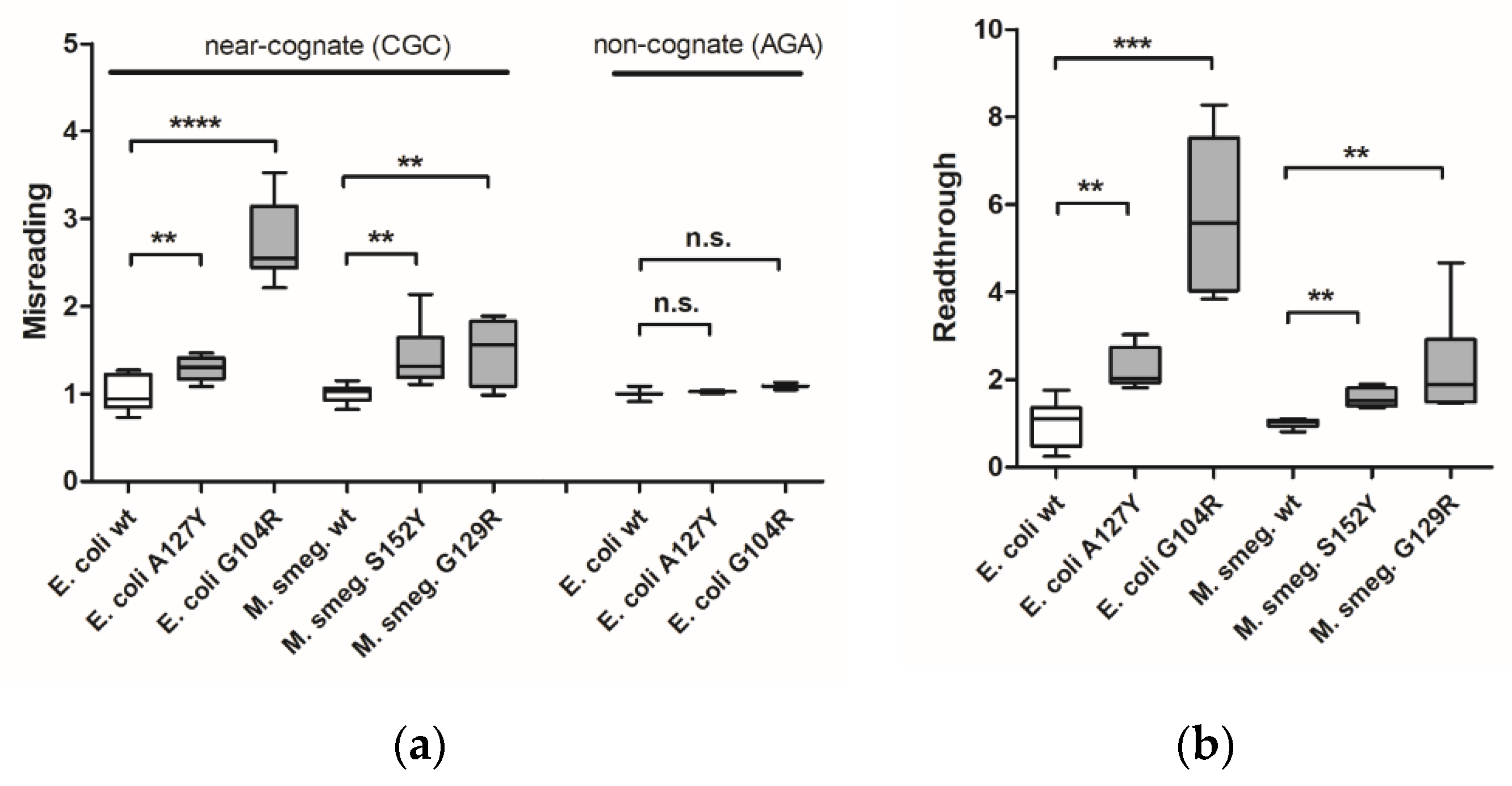
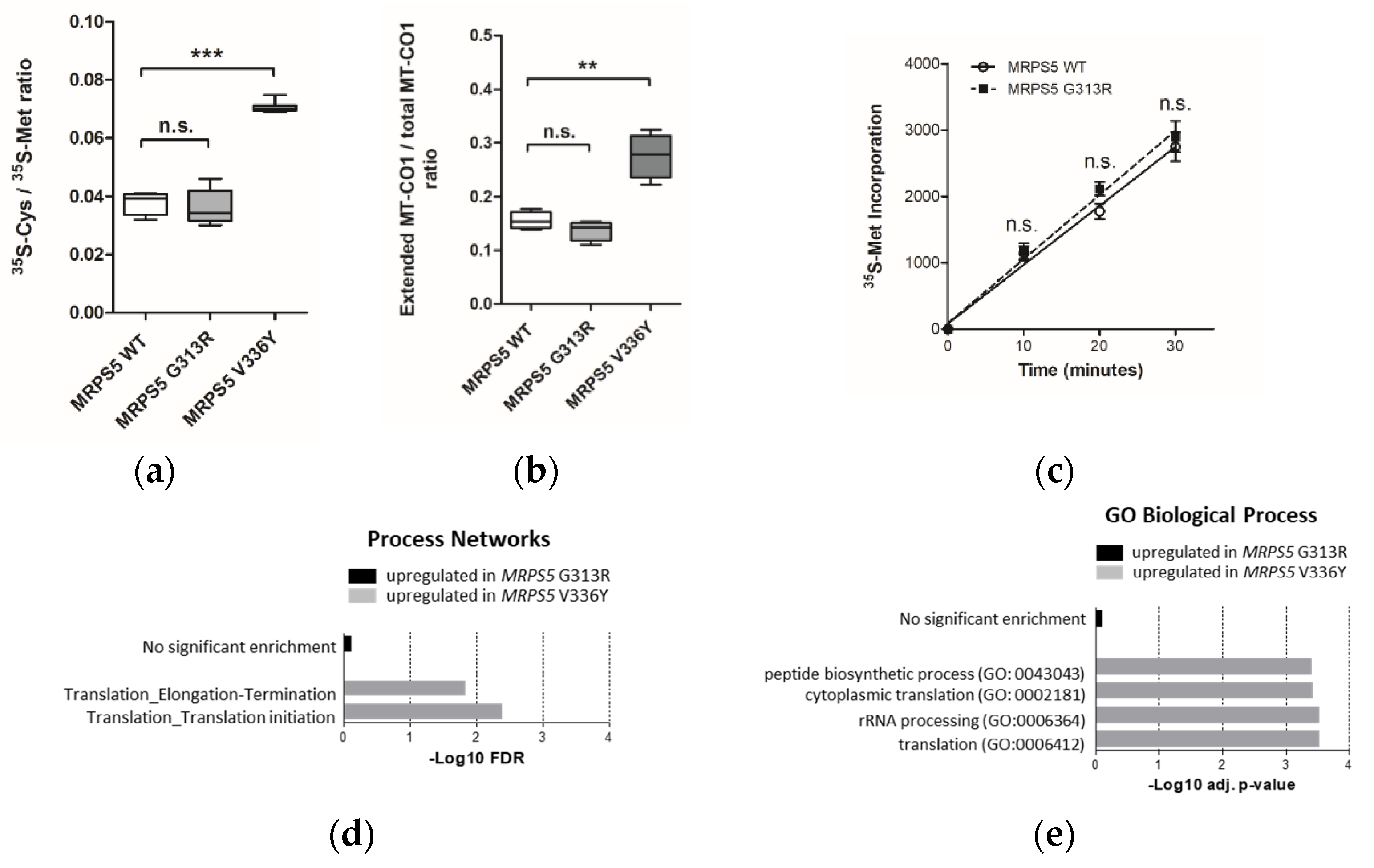
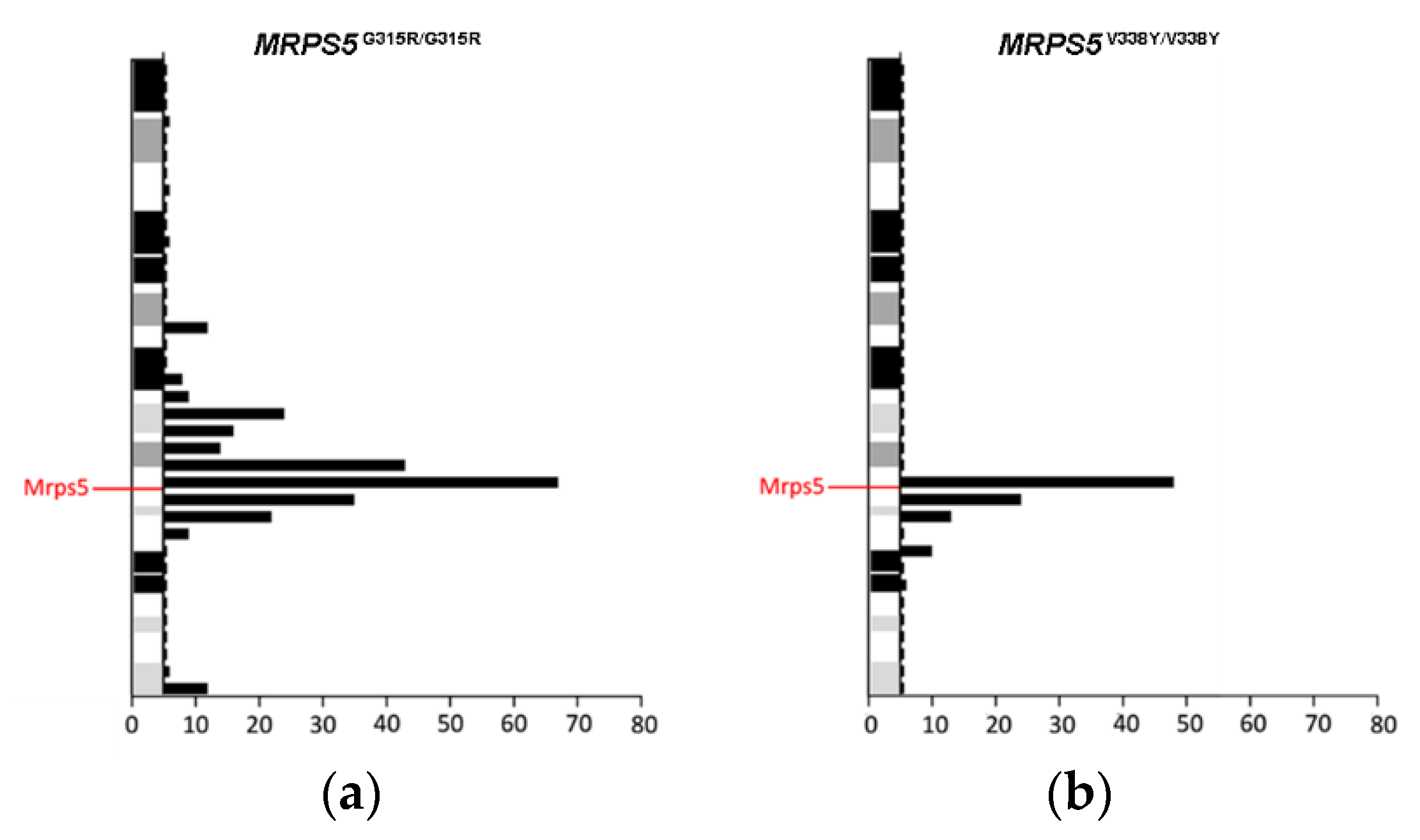


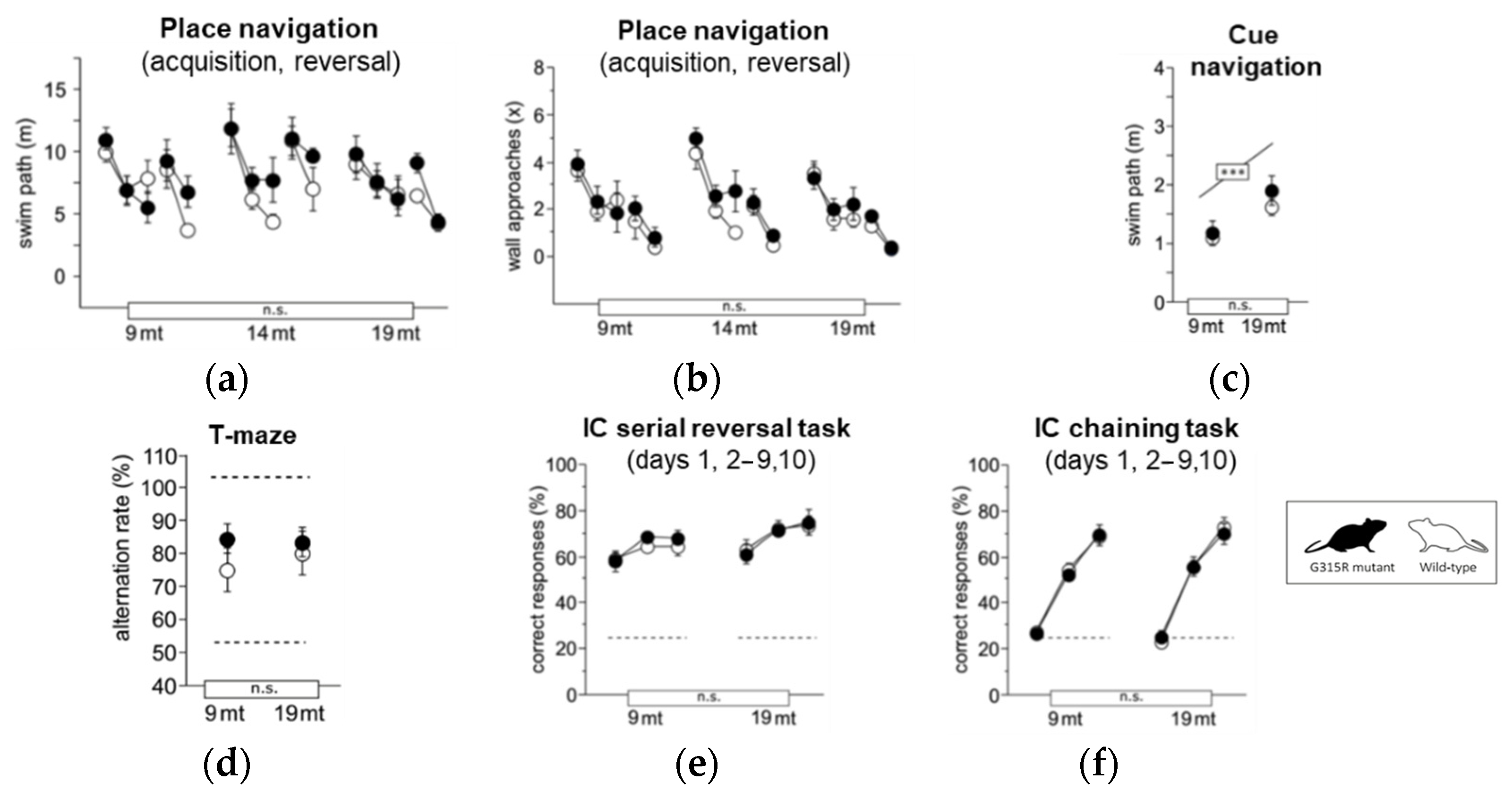
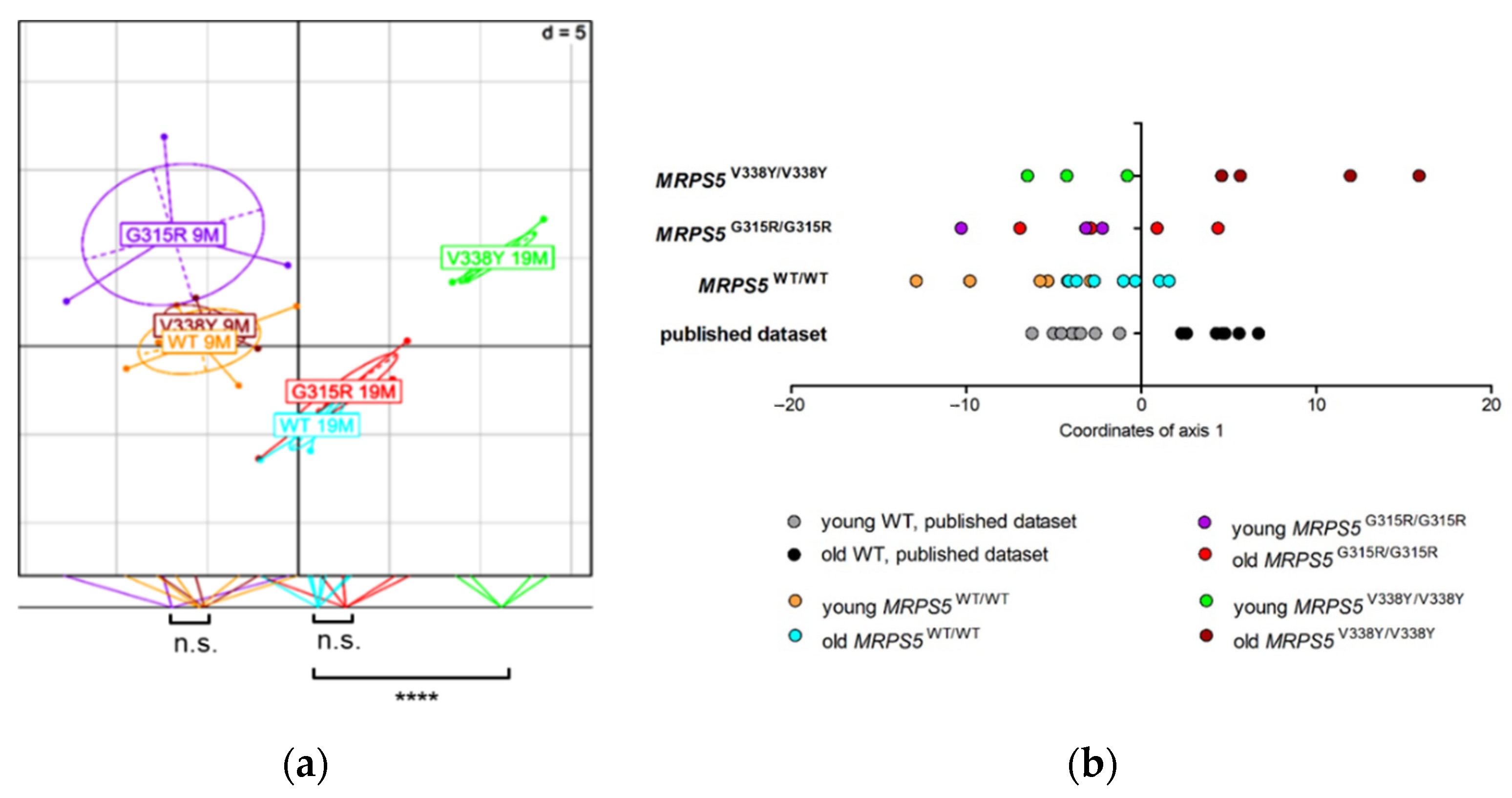
Publisher’s Note: MDPI stays neutral with regard to jurisdictional claims in published maps and institutional affiliations. |
© 2022 by the authors. Licensee MDPI, Basel, Switzerland. This article is an open access article distributed under the terms and conditions of the Creative Commons Attribution (CC BY) license (https://creativecommons.org/licenses/by/4.0/).
Share and Cite
Juskeviciene, R.; Fritz, A.-K.; Brilkova, M.; Akbergenov, R.; Schmitt, K.; Rehrauer, H.; Laczko, E.; Isnard-Petit, P.; Thiam, K.; Eckert, A.; et al. Phenotype of Mrps5-Associated Phylogenetic Polymorphisms Is Intimately Linked to Mitoribosomal Misreading. Int. J. Mol. Sci. 2022, 23, 4384. https://doi.org/10.3390/ijms23084384
Juskeviciene R, Fritz A-K, Brilkova M, Akbergenov R, Schmitt K, Rehrauer H, Laczko E, Isnard-Petit P, Thiam K, Eckert A, et al. Phenotype of Mrps5-Associated Phylogenetic Polymorphisms Is Intimately Linked to Mitoribosomal Misreading. International Journal of Molecular Sciences. 2022; 23(8):4384. https://doi.org/10.3390/ijms23084384
Chicago/Turabian StyleJuskeviciene, Reda, Ann-Kristina Fritz, Margarita Brilkova, Rashid Akbergenov, Karen Schmitt, Hubert Rehrauer, Endre Laczko, Patricia Isnard-Petit, Kader Thiam, Anne Eckert, and et al. 2022. "Phenotype of Mrps5-Associated Phylogenetic Polymorphisms Is Intimately Linked to Mitoribosomal Misreading" International Journal of Molecular Sciences 23, no. 8: 4384. https://doi.org/10.3390/ijms23084384
APA StyleJuskeviciene, R., Fritz, A.-K., Brilkova, M., Akbergenov, R., Schmitt, K., Rehrauer, H., Laczko, E., Isnard-Petit, P., Thiam, K., Eckert, A., Schacht, J., Wolfer, D. P., Böttger, E. C., & Shcherbakov, D. (2022). Phenotype of Mrps5-Associated Phylogenetic Polymorphisms Is Intimately Linked to Mitoribosomal Misreading. International Journal of Molecular Sciences, 23(8), 4384. https://doi.org/10.3390/ijms23084384






